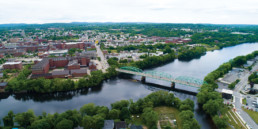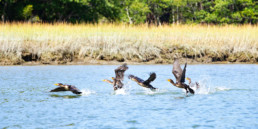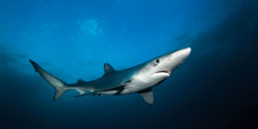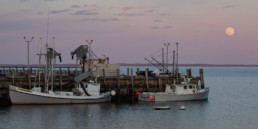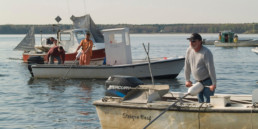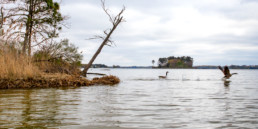The Unique Environment of Island Forests
Sea, salt, cool fog, and wind shape the wooded areas of islands
Story by Catherine Schmitt and photos by Jack Sullivan
Imagine being at sea for weeks, months, or years, seeing only blue, gray, and the foaming white of cresting waves. Imagine smelling only salt, minerals, fish, and then, one day, catching the faintest scent of something different, like honey mixed with cinnamon and turpentine. On the horizon, a black blur slowly resolves into solid green.
Trees, land, destination! Rock islands tufted with dark green spires, their needles sending aromatic messages into the wind. Forest. Earth. Home!
Maine island forests share many characteristics with the great North Woods that stretch across the northern tier of the continent. But, in many other ways, island forests are unique. Surrounded and shaped by the sea, island woods are influenced by cool temperatures, wind, waves, salt spray, and fog.
Especially northeast of Penobscot Bay, the coast experiences twice as many hours of fog because cold currents from the Arctic flow close to shore. Boreal evergreens like spruce and balsam fir flourish in the cool, moist climate. Salt-tolerant, fast-growing white spruce grow right along the seaward edge, their roots holding island soil in place. Red spruce, balsam fir, paper birch, yellow birch, and red maple are common.
These trees attract sharp-shinned hawks, yellow-bellied flycatchers and flickers, warblers, chickadees, and crossbills. Leach’s storm-petrels burrow in fallen logs and roots. Eagles nest on white pine branches high above the canopy.
Mammals are few on distant, isolated islands (meadow voles, masked shrews, maybe mink) but common on nearshore islands and include moose, deer, muskrat, porcupine, raccoon, red squirrel, snowshoe hare, and otters.
Mammals and birds feeding on mussels and urchins leave shells strewn about the woods, a small but not insignificant influx of marine nutrients.
The understory might include small firs, alder, sheep laurel, blueberry, and, right under the spruce, twin-petaled white flowers of dwarf enchantress-nightshade. But mostly, there are lichens—bloodstain lichens, granular lichens, budding tube lichens, crottle and beard lichens crusting ocean-facing trees—and moss. Big red-stem moss, stairstep and broom mosses, three-lobed and leafy liverworts cover the ground, and overtake fallen trees, of which there are many.
As Island Institute founder Philip Conkling wrote in Islands in Time, these forests are “the realm of the rugged.”
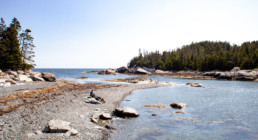
Islands bear the brunt of coastal storms, and windthrown trees define island forest form and function. As trees along the edge die and blow over, wind reaches more of the interior, blowing more trees down, creating gaps in the overstory where sunlight pours in and reaches plants on the forest floor. As a result of such intense and frequent disturbances, island forests tend to be younger, especially around their edges.
Maine island forests are also younger because so many of the islands were cleared in the last few hundred years.
In the Dawnland home of the Wabanaki, islands were and continue to be places for hunting, fishing, foraging, creating, living. But historically, indigenous people lost access as islands were among the first places colonized by Europeans.
In the warmer, drier region south of Penobscot Bay, colonists quickly cut large white pines along with hardwoods like oak, chestnut, walnut, and hickory. Later, they cleared spruce and fir on northern islands to make way for farming and sheep grazing, and trees were cut and sent to shipyards, lime kilns, and paper mills. They re-named islands after what they took from the forests: Hardwood, Clapboard, Stave.
Land clearing peaked in the second half of the 19th century. The varied histories of human use, along with differing geology, soil, climate, and exposure to wind and waves, along with the mystery of forces beyond human knowledge, mean that each island’s forest is unpredictably unique.
Take, for example, the small, domed island called Bar Island, at the head of Somes Sound on Mount Desert Island. Pines and oaks more than a hundred years-old shade an understory of scattered fir and birch. Standing dead trees are half-rotted, hole-ridden snags; others lay fallen across the ground and each other. Moss grows on stacked stones of an old well, and trees are choked by garden plants gone wild on the flat terrace of a one-time piazza. The mix of red and white pine and oak is unusual in the Acadia archipelago.
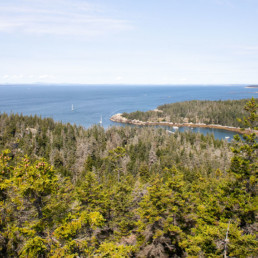
Just the slightest difference can create contrasting forests, even on adjacent islands. White spruce typically grows only along the most seaward edge, as on Little Moose Island, but nearby Schoodic Island is all white spruce. Little Duck Island is dominated by balsam fir, but spruce dominates on neighboring Great Duck Island, which is flatter and thus more exposed to salt spray.
The sea, of course, is the strongest influence. Island forests can be thick with fog even on days when the mainland is hot and dry. On Bald Porcupine Island, northern white cedars, typically found in wet areas, have grown on high, dry ground for 200 years, perhaps drawing their needed moisture from fog.
Fog and the relatively cool temperatures of the Gulf of Maine allowed spruce and fir to persist on the Downeast coast even as the climate changed since the end of the last ice age. Studies of fossil pollen buried in lake and wetland sediments show that spruce has grown continuously for 2,000 years on Mount Desert Island, 5,000 years on Isle au Haut, and 9,500 years on Roque Island.
Temperatures are changing today much faster than in the past. Storms are increasing. Will spruce-fir forest continue to find refuge in the maritime air of the Maine islands?
“The eastern half of the coast, we’re going to see some major change in island vegetation,” said Glen Mittelhauser of the Maine Natural History Observatory, who led a 1990s study of Acadia islands with the help of Earthwatch volunteers. “But the last place where spruce will linger is probably on these islands.”
A follow-up study in 2018, also aided by Earthwatch volunteers, and monitoring by the National Park Service, show that Acadia’s island forests are aging but not drastically changing. But threats loom in the form of invasive plants and pests: glossy buckthorn, barberry, winter and browntail moths, and red pine scale, which has killed the red pines on Bar Island in Somes Sound.
Changes in island forests will ultimately affect the sea. Rain and snowmelt flow through the woods into streams that empty into small bays, or soaks through the ground and seep out where the forest floor meets the tideline. Fulvic acid leached from leaves picks up iron as it filters through roots and soil, supplying this important mineral to phytoplankton, seaweed, and fish.
As they turn into driftwood on the sun- and salt-baked rocks, fallen and broken trees make good perches and burrows. Driftwood attracts wood-boring crustaceans, mollusks, shipworms, and the ocean strider, an insect that attaches its eggs to floating wood. The very existence of these animals shows the evolved connections between island trees and the sea, and the many intricate relationships of forest, earth, and home.
Catherine Schmitt is the author of Historic Acadia National Park, The President’s Salmon, and A Coastal Companion: A Year in the Gulf of Maine from Cape Cod to Canada. She is a science writer with Schoodic Institute at Acadia National Park. Find more of her work at catherineschmitt.com.

